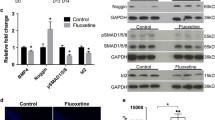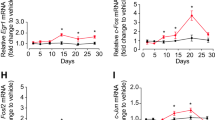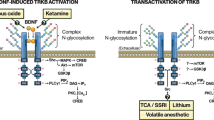Abstract
The benefits of current treatments for depression are limited by low response rates, delayed therapeutic effects, and multiple side effects. Antidepressants affect a variety of neurotransmitter systems in different areas of the brain, and the mechanisms underlying their convergent effects on behavior have been unclear. Here we identify hippocampal bone morphogenetic protein (BMP) signaling as a common downstream pathway that mediates the behavioral effects of five different antidepressant classes (fluoxetine, bupropion, duloxetine, vilazodone, trazodone) and of electroconvulsive therapy. All of these therapies decrease BMP signaling and enhance neurogenesis in the hippocampus. Preventing the decrease in BMP signaling blocks the effect of antidepressant treatment on behavioral phenotypes. Further, inhibition of BMP signaling in hippocampal newborn neurons is sufficient to produce an antidepressant effect, while chemogenetic silencing of newborn neurons prevents the antidepressant effect. Thus, inhibition of hippocampal BMP signaling is both necessary and sufficient to mediate the effects of multiple classes of antidepressants.






Similar content being viewed by others
Availability of data and material
All data needed to evaluate the conclusions in the paper are present in the paper and/or the Supplementary Materials.
References
World Health Organization WHO (2017) Depression and other common mental disorders: global health estimates
Lepine JP, Briley M (2011) The increasing burden of depression. Neuropsychiatr Dis Treat 7(Suppl 1):3–7. https://doi.org/10.2147/NDT.S19617 (Epub 2011/07/14)
Taylor C, Fricker AD, Devi LA, Gomes I (2005) Mechanisms of action of antidepressants: from neurotransmitter systems to signaling pathways. Cell Signal 17(5):549–557. https://doi.org/10.1016/j.cellsig.2004.12.007 (Epub 2005/02/03)
Haenisch B, Bonisch H (2011) Depression and antidepressants: insights from knockout of dopamine, serotonin or noradrenaline re-uptake transporters. Pharmacol Ther 129(3):352–368. https://doi.org/10.1016/j.pharmthera.2010.12.002 (Epub 2010/12/15)
Li YF (2020) A hypothesis of monoamine (5-HT)—glutamate/GABA long neural circuit: aiming for fast-onset antidepressant discovery. Pharmacol Ther 208:107494. https://doi.org/10.1016/j.pharmthera.2020.107494 (Epub 2020/01/29)
Harmer CJ, Duman RS, Cowen PJ (2017) How do antidepressants work? New perspectives for refining future treatment approaches. Lancet Psychiatry 4(5):409–418. https://doi.org/10.1016/S2215-0366(17)30015-9 (Epub 2017/02/06)
Murrough JW, Abdallah CG, Mathew SJ (2017) Targeting glutamate signalling in depression: progress and prospects. Nat Rev Drug Discov 16(7):472–486. https://doi.org/10.1038/nrd.2017.16 (Epub 2017/03/18)
Pitsillou E, Bresnehan SM, Kagarakis EA, Wijoyo SJ, Liang J, Hung A, Karagiannis TC (2020) The cellular and molecular basis of major depressive disorder: towards a unified model for understanding clinical depression. Mol Biol Rep 47(1):753–770. https://doi.org/10.1007/s11033-019-05129-3 (Epub 2019/10/16)
Bruhl AB, Jancke L, Herwig U (2011) Differential modulation of emotion processing brain regions by noradrenergic and serotonergic antidepressants. Psychopharmacology 216(3):389–399. https://doi.org/10.1007/s00213-011-2227-2 (Epub 2011/03/02)
An J, Wang L, Li K, Zeng Y, Su Y, Jin Z, Yu X, Si T (2017) Differential effects of antidepressant treatment on long-range and short-range functional connectivity strength in patients with major depressive disorder. Sci Rep 7(1):10214. https://doi.org/10.1038/s41598-017-10575-9 (Epub 2017/09/02)
Ichikawa N, Lisi G, Yahata N, Okada G, Takamura M, Hashimoto RI, Yamada T, Yamada M, Suhara T, Moriguchi S, Mimura M, Yoshihara Y, Takahashi H, Kasai K, Kato N, Yamawaki S, Seymour B, Kawato M, Morimoto J, Okamoto Y (2020) Primary functional brain connections associated with melancholic major depressive disorder and modulation by antidepressants. Sci Rep 10(1):3542. https://doi.org/10.1038/s41598-020-60527-z (Epub 2020/02/28)
Malberg JE (2004) Implications of adult hippocampal neurogenesis in antidepressant action. J Psychiatry Neurosci 29(3):196–205 (Epub 2004/06/03)
Boldrini M, Santiago AN, Hen R, Dwork AJ, Rosoklija GB, Tamir H, Arango V, John MJ (2013) Hippocampal granule neuron number and dentate gyrus volume in antidepressant-treated and untreated major depression. Neuropsychopharmacology 38(6):1068–1077. https://doi.org/10.1038/npp.2013.5 (Epub 2013/01/11)
Boldrini M, Underwood MD, Hen R, Rosoklija GB, Dwork AJ, John Mann J, Arango V (2009) Antidepressants increase neural progenitor cells in the human hippocampus. Neuropsychopharmacology 34(11):2376–2389. https://doi.org/10.1038/npp.2009.75 (Epub 2009/07/17)
Clarke M, Razmjou S, Prowse N, Dwyer Z, Litteljohn D, Pentz R, Anisman H, Hayley S (2017) Ketamine modulates hippocampal neurogenesis and pro-inflammatory cytokines but not stressor induced neurochemical changes. Neuropharmacology 112(Pt A):210–220. https://doi.org/10.1016/j.neuropharm.2016.04.021 (Epub 2016/10/25)
David DJ, Samuels BA, Rainer Q, Wang JW, Marsteller D, Mendez I, Drew M, Craig DA, Guiard BP, Guilloux JP, Artymyshyn RP, Gardier AM, Gerald C, Antonijevic IA, Leonardo ED, Hen R (2009) Neurogenesis-dependent and -independent effects of fluoxetine in an animal model of anxiety/depression. Neuron 62(4):479–493. https://doi.org/10.1016/j.neuron.2009.04.017 (Epub 2009/05/30)
Eisch AJ, Petrik D (2012) Depression and hippocampal neurogenesis: a road to remission? Science 338(6103):72–75. https://doi.org/10.1126/science.1222941 (Epub 2012/10/09)
Villas Boas GR, Boerngen de Lacerda R, Paes MM, Gubert P, Almeida W, Rescia VC, de Carvalho PMG, de Carvalho AAV, Oesterreich SA (2019) Molecular aspects of depression: a review from neurobiology to treatment. Eur J Pharmacol 851:99–121. https://doi.org/10.1016/j.ejphar.2019.02.024 (Epub 2019/02/19)
Naoi M, Maruyama W, Shamoto-Nagai M (2018) Type A monoamine oxidase and serotonin are coordinately involved in depressive disorders: from neurotransmitter imbalance to impaired neurogenesis. J Neural Transm (Vienna) 125(1):53–66. https://doi.org/10.1007/s00702-017-1709-8 (Epub 2017/03/16)
Han X, Tong J, Zhang J, Farahvar A, Wang E, Yang J, Samadani U, Smith DH, Huang JH (2011) Imipramine treatment improves cognitive outcome associated with enhanced hippocampal neurogenesis after traumatic brain injury in mice. J Neurotrauma 28(6):995–1007. https://doi.org/10.1089/neu.2010.1563 (Epub 2011/04/06)
Morais M, Santos PA, Mateus-Pinheiro A, Patricio P, Pinto L, Sousa N, Pedroso P, Almeida S, Filipe A, Bessa JM (2014) The effects of chronic stress on hippocampal adult neurogenesis and dendritic plasticity are reversed by selective MAO-A inhibition. J Psychopharmacol 28(12):1178–1183. https://doi.org/10.1177/0269881114553646 (Epub 2014/10/16)
Santarelli L, Saxe M, Gross C, Surget A, Battaglia F, Dulawa S, Weisstaub N, Lee J, Duman R, Arancio O, Belzung C, Hen R (2003) Requirement of hippocampal neurogenesis for the behavioral effects of antidepressants. Science 301(5634):805–809. https://doi.org/10.1126/science.1083328 (Epub 2003/08/09)
Mostany R, Valdizan EM, Pazos A (2008) A role for nuclear beta-catenin in SNRI antidepressant-induced hippocampal cell proliferation. Neuropharmacology 55(1):18–26. https://doi.org/10.1016/j.neuropharm.2008.04.012 (Epub 2008/05/31)
Belovicova K, Bogi E, Koprdova R, Ujhazy E, Mach M, Dubovicky M (2017) Effects of venlafaxine and chronic unpredictable stress on behavior and hippocampal neurogenesis of rat dams. Neuro Endocrinol Lett 38(1):19–26 (Epub 2017/05/01)
Tunc-Ozcan E, Peng CY, Zhu Y, Dunlop SR, Contractor A, Kessler JA (2019) Activating newborn neurons suppresses depression and anxiety-like behaviors. Nat Commun 10(1):3768. https://doi.org/10.1038/s41467-019-11641-8 (Epub 2019/08/23)
Wang JW, David DJ, Monckton JE, Battaglia F, Hen R (2008) Chronic fluoxetine stimulates maturation and synaptic plasticity of adult-born hippocampal granule cells. J Neurosci 28(6):1374–1384. https://doi.org/10.1523/JNEUROSCI.3632-07.2008 (Epub 2008/02/08)
Surget A, Tanti A, Leonardo ED, Laugeray A, Rainer Q, Touma C, Palme R, Griebel G, Ibarguen-Vargas Y, Hen R, Belzung C (2011) Antidepressants recruit new neurons to improve stress response regulation. Mol Psychiatry 16(12):1177–1188. https://doi.org/10.1038/mp.2011.48 (Epub 2011/05/04)
Surget A, Saxe M, Leman S, Ibarguen-Vargas Y, Chalon S, Griebel G, Hen R, Belzung C (2008) Drug-dependent requirement of hippocampal neurogenesis in a model of depression and of antidepressant reversal. Biol Psychiatry 64(4):293–301. https://doi.org/10.1016/j.biopsych.2008.02.022 (Epub 2008/04/15)
Ueno M, Sugimoto M, Ohtsubo K, Sakai N, Endo A, Shikano K, Imoto Y, Segi-Nishida E (2019) The effect of electroconvulsive seizure on survival, neuronal differentiation, and expression of the maturation marker in the adult mouse hippocampus. J Neurochem 149(4):488–498. https://doi.org/10.1111/jnc.14691 (Epub 2019/03/03)
Madsen TM, Treschow A, Bengzon J, Bolwig TG, Lindvall O, Tingstrom A (2000) Increased neurogenesis in a model of electroconvulsive therapy. Biol Psychiatry 47(12):1043–1049. https://doi.org/10.1016/s0006-3223(00)00228-6 (Epub 2000/06/23)
Brooker SM, Gobeske KT, Chen J, Peng CY, Kessler JA (2017) Hippocampal bone morphogenetic protein signaling mediates behavioral effects of antidepressant treatment. Mol Psychiatry 22(6):910–919. https://doi.org/10.1038/mp.2016.160 (Epub 2016/10/05)
Bond AM, Bhalala OG, Kessler JA (2012) The dynamic role of bone morphogenetic proteins in neural stem cell fate and maturation. Dev Neurobiol 72(7):1068–1084. https://doi.org/10.1002/dneu.22022 (Epub 2012/04/11)
Bond AM, Peng CY, Meyers EA, McGuire T, Ewaleifoh O, Kessler JA (2014) BMP signaling regulates the tempo of adult hippocampal progenitor maturation at multiple stages of the lineage. Stem Cells 32(8):2201–2214. https://doi.org/10.1002/stem.1688 (Epub 2014/03/01)
Bonaguidi MA, McGuire T, Hu M, Kan L, Samanta J, Kessler JA (2005) LIF and BMP signaling generate separate and discrete types of GFAP-expressing cells. Development 132(24):5503–5514. https://doi.org/10.1242/dev.02166 (Epub 2005/11/30)
Patricio P, Mateus-Pinheiro A, Sousa N, Pinto L (2013) Re-cycling paradigms: cell cycle regulation in adult hippocampal neurogenesis and implications for depression. Mol Neurobiol 48(1):84–96. https://doi.org/10.1007/s12035-013-8422-x (Epub 2013/03/09)
Mira H, Andreu Z, Suh H, Lie DC, Jessberger S, Consiglio A, San Emeterio J, Hortiguela R, Marques-Torrejon MA, Nakashima K, Colak D, Gotz M, Farinas I, Gage FH (2010) Signaling through BMPR-IA regulates quiescence and long-term activity of neural stem cells in the adult hippocampus. Cell Stem Cell 7(1):78–89. https://doi.org/10.1016/j.stem.2010.04.016 (Epub 2010/07/14)
Yousef H, Morgenthaler A, Schlesinger C, Bugaj L, Conboy IM, Schaffer DV (2015) Age-associated increase in BMP signaling inhibits hippocampal neurogenesis. Stem Cells 33(5):1577–1588. https://doi.org/10.1002/stem.1943 (Epub 2014/12/30)
Choe Y, Pleasure SJ, Mira H (2015) Control of adult neurogenesis by short-range morphogenic-signaling molecules. Cold Spring Harb Perspect Biol 8(3):a018887. https://doi.org/10.1101/cshperspect.a018887 (Epub 2015/12/08)
Gobeske KT, Das S, Bonaguidi MA, Weiss C, Radulovic J, Disterhoft JF, Kessler JA (2009) BMP signaling mediates effects of exercise on hippocampal neurogenesis and cognition in mice. PLoS ONE 4(10):e7506. https://doi.org/10.1371/journal.pone.0007506 (Epub 2009/10/21)
Meyers EA, Gobeske KT, Bond AM, Jarrett JC, Peng CY, Kessler JA (2016) Increased bone morphogenetic protein signaling contributes to age-related declines in neurogenesis and cognition. Neurobiol Aging 38:164–175. https://doi.org/10.1016/j.neurobiolaging.2015.10.035 (Epub 2016/02/02)
Gomes WA, Mehler MF, Kessler JA (2003) Transgenic overexpression of BMP4 increases astroglial and decreases oligodendroglial lineage commitment. Dev Biol 255(1):164–177. https://doi.org/10.1016/s0012-1606(02)00037-4 (Epub 2003/03/06)
Forss-Petter S, Danielson PE, Catsicas S, Battenberg E, Price J, Nerenberg M, Sutcliffe JG (1990) Transgenic mice expressing beta-galactosidase in mature neurons under neuron-specific enolase promoter control. Neuron 5(2):187–197. https://doi.org/10.1016/0896-6273(90)90308-3 (Epub 1990/08/01)
Zhu H, Aryal DK, Olsen RH, Urban DJ, Swearingen A, Forbes S, Roth BL, Hochgeschwender U (2016) Cre-dependent DREADD (designer receptors exclusively activated by designer drugs) mice. Genesis 54(8):439–446. https://doi.org/10.1002/dvg.22949 (Epub 2016/05/20)
Guettier JM, Gautam D, Scarselli M, Ruiz de Azua I, Li JH, Rosemond E, Ma X, Gonzalez FJ, Armbruster BN, Lu H, Roth BL, Wess J (2009) A chemical-genetic approach to study G protein regulation of beta cell function in vivo. Proc Natl Acad Sci USA 106(45):19197–19202. https://doi.org/10.1073/pnas.0906593106 (Epub 2009/10/28)
Kim EJ, Ables JL, Dickel LK, Eisch AJ, Johnson JE (2011) Ascl1 (Mash1) defines cells with long-term neurogenic potential in subgranular and subventricular zones in adult mouse brain. PLoS ONE 6(3):e18472. https://doi.org/10.1371/journal.pone.0018472 (Epub 2011/04/13)
Brown WC, Schiffman DO, Swinyard EA, Goodman LS (1953) Comparative assay of an antiepileptic drugs by psychomotor seizure test and minimal electroshock threshold test. J Pharmacol Exp Ther 107(3):273–283 (Epub 1953/03/01)
Frankel WN, Taylor L, Beyer B, Tempel BL, White HS (2001) Electroconvulsive thresholds of inbred mouse strains. Genomics 74(3):306–312. https://doi.org/10.1006/geno.2001.6564 (Epub 2001/06/21)
Woodbury LA, Davenport VD (1952) Design and use of a new electroshock seizure apparatus, and analysis of factors altering seizure threshold and pattern. Arch Int Pharmacodyn Ther 92(1):97–107 (Epub 1952/10/01)
Lim DA, Tramontin AD, Trevejo JM, Herrera DG, Garcia-Verdugo JM, Alvarez-Buylla A (2000) Noggin antagonizes BMP signaling to create a niche for adult neurogenesis. Neuron 28(3):713–726. https://doi.org/10.1016/s0896-6273(00)00148-3 (Epub 2001/02/13)
Unger MS, Marschallinger J, Kaindl J, Klein B, Johnson M, Khundakar AA, Rossner S, Heneka MT, Couillard-Despres S, Rockenstein E, Masliah E, Attems J, Aigner L (2018) Doublecortin expression in CD8+ T-cells and microglia at sites of amyloid-beta plaques: a potential role in shaping plaque pathology? Alzheimers Dement 14(8):1022–1037. https://doi.org/10.1016/j.jalz.2018.02.017 (Epub 2018/04/10)
Ackman JB, Siddiqi F, Walikonis RS, LoTurco JJ (2006) Fusion of microglia with pyramidal neurons after retroviral infection. J Neurosci 26(44):11413–11422. https://doi.org/10.1523/JNEUROSCI.3340-06.2006 (Epub 2006/11/03)
Nollet M, Le Guisquet AM, Belzung C (2013) Models of depression: unpredictable chronic mild stress in mice. Curr Protoc Pharmacol 5(5):65. https://doi.org/10.1002/0471141755.ph0565s61 (Epub 2013/06/08)
Baudry A, Mouillet-Richard S, Schneider B, Launay JM, Kellermann O (2010) miR-16 targets the serotonin transporter: a new facet for adaptive responses to antidepressants. Science 329(5998):1537–1541. https://doi.org/10.1126/science.1193692 (Epub 2010/09/18)
Elliott E, Ezra-Nevo G, Regev L, Neufeld-Cohen A, Chen A (2010) Resilience to social stress coincides with functional DNA methylation of the Crf gene in adult mice. Nat Neurosci 13(11):1351–1353. https://doi.org/10.1038/nn.2642 (Epub 2010/10/05)
Issler O, Haramati S, Paul ED, Maeno H, Navon I, Zwang R, Gil S, Mayberg HS, Dunlop BW, Menke A, Awatramani R, Binder EB, Deneris ES, Lowry CA, Chen A (2014) MicroRNA 135 is essential for chronic stress resiliency, antidepressant efficacy, and intact serotonergic activity. Neuron 83(2):344–360. https://doi.org/10.1016/j.neuron.2014.05.042 (Epub 2014/06/24)
Tanti A, Westphal WP, Girault V, Brizard B, Devers S, Leguisquet AM, Surget A, Belzung C (2013) Region-dependent and stage-specific effects of stress, environmental enrichment, and antidepressant treatment on hippocampal neurogenesis. Hippocampus 23(9):797–811. https://doi.org/10.1002/hipo.22134 (Epub 2013/04/18)
Chang M, Zhang L, Dai H, Sun L (2021) Genistein acts as antidepressant agent against chronic mild stress-induced depression model of rats through augmentation of brain-derived neurotrophic factor. Brain Behav 11(8):e2300. https://doi.org/10.1002/brb3.2300 (Epub 2021/08/02)
Gall Z, Farkas S, Albert A, Ferencz E, Vancea S, Urkon M, Kolcsar M (2020) Effects of chronic cannabidiol treatment in the rat chronic unpredictable mild stress model of depression. Biomolecules. https://doi.org/10.3390/biom10050801 (Epub 2020/05/28)
Habib MZ, Ebeid MA, El Faramawy Y, Saad SST, El Magdoub HM, Attia AA, Aboul-Fotouh S, Abdel-Tawab AM (2020) Effects of lithium on cytokine neuro-inflammatory mediators, Wnt/beta-catenin signaling and microglial activation in the hippocampus of chronic mild stress-exposed rats. Toxicol Appl Pharmacol 399:115073. https://doi.org/10.1016/j.taap.2020.115073 (Epub 2020/05/27)
Kudryashov NV, Kalinina TS, Shimshirt AA, Volkova AV, Narkevich VB, Naplekova PL, Kasabov KA, Kudrin VS, Voronina TA, Fisenko VP (2020) The behavioral and neurochemical aspects of the interaction between antidepressants and unpredictable chronic mild stress. Acta Naturae 12(1):63–72. https://doi.org/10.32607/actanaturae.10942 (Epub 2020/06/02)
Guha U, Mecklenburg L, Cowin P, Kan L, O’Guin WM, D’Vizio D, Pestell RG, Paus R, Kessler JA (2004) Bone morphogenetic protein signaling regulates postnatal hair follicle differentiation and cycling. Am J Pathol 165(3):729–740. https://doi.org/10.1016/S0002-9440(10)63336-6 (Epub 2004/08/28)
Armbruster BN, Li X, Pausch MH, Herlitze S, Roth BL (2007) Evolving the lock to fit the key to create a family of G protein-coupled receptors potently activated by an inert ligand. Proc Natl Acad Sci USA 104(12):5163–5168. https://doi.org/10.1073/pnas.0700293104 (Epub 2007/03/16)
Rogan SC, Roth BL (2011) Remote control of neuronal signaling. Pharmacol Rev 63(2):291–315. https://doi.org/10.1124/pr.110.003020 (Epub 2011/03/19)
Voineskos D, Daskalakis ZJ, Blumberger DM (2020) Management of treatment-resistant depression: challenges and strategies. Neuropsychiatr Dis Treat 16:221–234. https://doi.org/10.2147/NDT.S198774 (Epub 2020/02/06)
Bjorkholm C, Monteggia LM (2016) BDNF—a key transducer of antidepressant effects. Neuropharmacology 102:72–79. https://doi.org/10.1016/j.neuropharm.2015.10.034 (Epub 2015/11/01)
Gergues MM, Yohn CN, Bharadia A, Levinstein MR, Samuels BA (2021) Dentate gyrus activin signaling mediates the antidepressant response. Transl Psychiatry 11(1):7. https://doi.org/10.1038/s41398-020-01156-y (Epub 2021/01/09)
Videbech P, Ravnkilde B (2004) Hippocampal volume and depression: a meta-analysis of MRI studies. Am J Psychiatry 161(11):1957–1966. https://doi.org/10.1176/appi.ajp.161.11.1957 (Epub 2004/10/30)
Milne A, MacQueen GM, Yucel K, Soreni N, Hall GB (2009) Hippocampal metabolic abnormalities at first onset and with recurrent episodes of a major depressive disorder: a proton magnetic resonance spectroscopy study. Neuroimage 47(1):36–41. https://doi.org/10.1016/j.neuroimage.2009.03.031 (Epub 2009/03/28)
Drevets WC (2000) Functional anatomical abnormalities in limbic and prefrontal cortical structures in major depression. Prog Brain Res 126:413–431. https://doi.org/10.1016/S0079-6123(00)26027-5 (Epub 2000/12/06)
Yun S, Reynolds RP, Masiulis I, Eisch AJ (2016) Re-evaluating the link between neuropsychiatric disorders and dysregulated adult neurogenesis. Nat Med 22(11):1239–1247. https://doi.org/10.1038/nm.4218 (Epub 2016/11/01)
Acknowledgements
We thank Dr. Jennifer A. Kearney and Dr. Nicole A. Hawkins for their advice on Electroconvulsive Therapy (Basic auricular electroconvulsive test-ECT) and for sharing their ECT Unit # 57800-001: UGO BASILE Biological Research Apparatus with us. We acknowledge the assistance of the Northwestern University Behavioral Phenotyping Core facility.
Funding
This work was supported by NIH Grant R01 MH114923 to JAK and by the Davee Foundation.
Author information
Authors and Affiliations
Contributions
ETO designed and performed experiments, interpreted the data, and wrote the manuscript. SMB designed and performed experiments and edited the manuscript. JAB performed experiments and edited the manuscript. YT helped with immunohistochemistry. RR helped with in situ hybridization and data analysis. TLM prepared lentivirus and supervised lentivirus experiments. CP and JAK supported the studies with key experimental suggestions, research design, data interpretation, and manuscript preparation.
Corresponding author
Ethics declarations
Conflict of interest
The authors declare that they have no competing interests.
Consent to participate
Not applicable.
Consent for publication
Not applicable.
Ethics approval
All animal procedures were approved by the Northwestern University Animal Care and Use Committee.
Additional information
Publisher's Note
Springer Nature remains neutral with regard to jurisdictional claims in published maps and institutional affiliations.
Supplementary Information
Below is the link to the electronic supplementary material.
Rights and permissions
About this article
Cite this article
Tunc-Ozcan, E., Brooker, S.M., Bonds, J.A. et al. Hippocampal BMP signaling as a common pathway for antidepressant action. Cell. Mol. Life Sci. 79, 31 (2022). https://doi.org/10.1007/s00018-021-04026-y
Received:
Revised:
Accepted:
Published:
DOI: https://doi.org/10.1007/s00018-021-04026-y




